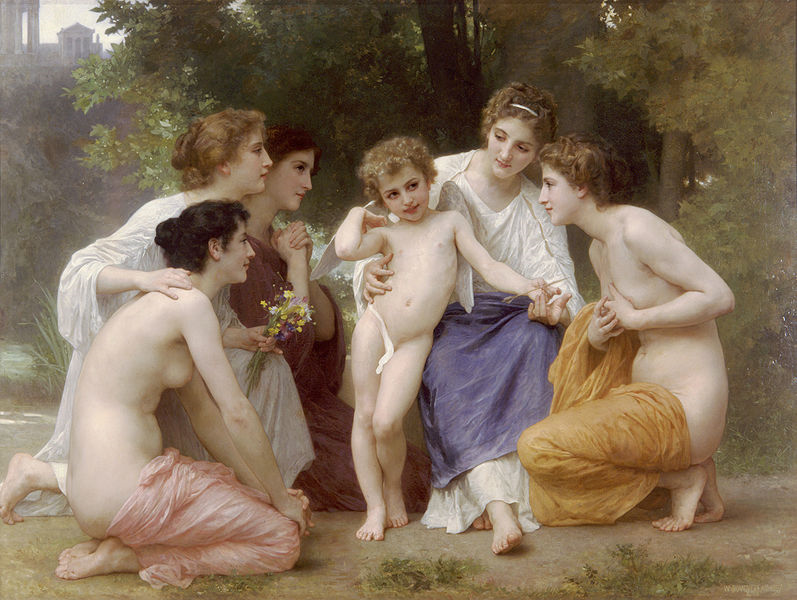Nineteenth century painting witnessed an unprecedented array of trends, ranging from Neoclassicism to Impressionism and Symbolism. In this variety of currents, there still were artists who managed to preserve their dedication to one trend throughout whole their life.
One of them is William Adolphe Bouguereau, a French academic painter who kept true to realistic genre paintings and traditional mythological subjects (Grove Dictionary 40). Bouguereau’s oil on canvas Adoration (1897) is a classical example of Academic-style painting, involving an almost photo-realistic depiction of the models in a pseudo-mythological scene.
Bouguereau’s academism reveals itself in the way the artist employs visual elements and principles. The clear, transparent colors set off the main group against a darker background and make it almost glowing, tinting the perfect translucent skin by the soft dark coloring of some clothing.
The color palette is reserved and yet serene, which supports the general calm and tranquil mood of the painting. The gentle lines of the bodies merge in harmony, revealing the natural perfection of human stature. Draped in softly falling tunics, the female bodies remind of the contours of the ancient statues. Polishing the skin texture to flawlessness, by play of light and shadow Bouguereau creates rounded and soft shapes that attract and delight by their innocent grace.
The center of interest in the painting, emphasized by the color contrasts, is definitely the central group of five young women, reaching out for a yet more important figure of a boy in the center of the composition. On the one hand, his figure is helping to balance the three female figures on the left.
On the other hand, he is a self-sufficient central figure. This visual balance is achieved by placing the boy’s body exactly in the middle of the painting and leveling out the three figures on the left by painting one of them in dark clothing and making it less visible at first sight.
The group of six is placed on a darker background of a forest — such “primeval woods” background is typical for Bouguereau (Van Hook 46); and yet farther at a distance one sees ancient temples placed on a hill. This three-level perspective reminds of the compositional principles practiced by the Renaissance artists.
Together with the formal aspects, Bouguereau employs semantic elements to emphasize his academic orientation. The title of the painting refers the viewer to the religious theme of adoration of the Magi. In Bouguereau’s Adoration, however, the Biblical figures of the Magi and the newborn Christ are replaced by the group of young women expressing their admiration to a flaunting boy.
This reminds, in its turn, of the ancient subject of adoration of Cupid by nymphs. The boy in Bouguereau’s painting possesses most of Cupid’s typical attributes: wings and arrow which he is still deciding where to shoot. Reminding of the Biblical Magi, one of the young women is holding a bouquet of flowers, as a gift to the newborn and a guarantee of his favor.
As a symbol of the painting’s reference to antiquity, Bouguereau places the silhouettes of the ancient temples in the background. The non-conflict, placid atmosphere of the painting reminds of the pastoral images of the Greeks and provides yet another link to the classical art.
Classified by his contemporaries as one of the most ardent followers of “academic realism”, William Adolphe Bouguereau confirms this title throughout all his creative life (Van Hook 43). One of his late works, Adoration, demonstrates how little his style changed, revealing impeccable academic professionalism both in visual elements and principles and in content and subject matter.
Works Cited
Bouguereau, William Adolphe. Admiration. 1897. San Antonio Museum of Art, San Antonio, Texas.
“Bouguereau, William(-Adolphe).” The Grove Dictionary of Art: From Monet to Cézanne: Late 19th-Century French Artists. 2000. Print.
Van Hook, Bailey. Angels of Art: Women and Art in American Society, 1876-1914. University Park, PA: Pennsylvania State University, 1996. Print.
